Force and Sound Pressure Sensors Used for Modeling the Impact of the Firearm with a Suppressor
Abstract
1. Introduction
2. Materials and Methods
3. Results
3.1. Measurements Results of the Firearm’s Backrest Force
3.2. Sound Pressure Measurement Results
4. Discussion
5. Conclusions
Author Contributions
Funding
Conflicts of Interest
References
- Branch, M.P. Comparison of Muzzle Suppression and Ear-Level Hearing Protection in Firearm Use. Otolaryngol. Head Neck Surg. 2011, 144, 950–953. [Google Scholar] [CrossRef] [PubMed]
- Arslan, H.; Ranjbar, M.; Secgin, E.; Celik, V. Theoretical and experimental investigation of acoustic performance of multi-chamber reactive silencers. Appl. Acoust. 2020, 157, 106987. [Google Scholar] [CrossRef]
- Strong, B.L.; Ballard, S.-B.; Braund, W. The American College of Preventive Medicine Policy Recommendations on Reducing and Preventing Firearm-Related Injuries and Deaths. Am. J. Prev. Med. 2016, 51, 1084–1089. [Google Scholar] [CrossRef] [PubMed]
- Itabashi, H.H.; Andrews, J.M.; Tomiyasu, U.; Erlich, S.S.; Sathyavagiswaran, L. Injuries due to firearms and other missile-launching devices. In Forensic Neuropathology; Elsevier: Amsterdam, The Netherlands, 2007; pp. 211–254. ISBN 978-0-12-058527-4. [Google Scholar]
- Hamilton, D.; Lemeshow, S.; Saleska, J.L.; Brewer, B.; Strobino, K. Who owns guns and how do they keep them? The influence of household characteristics on firearms ownership and storage practices in the United States. Prev. Med. 2018, 116, 134–142. [Google Scholar] [CrossRef]
- Fisher, H.; Drummond, A. A call to arms: The emergency physician, international perspectives on firearm injury prevention and the canadian gun control debate. J. Emerg. Med. 1999, 17, 529–537. [Google Scholar] [CrossRef]
- Jain, S.K.; Singh, B.P.; Singh, R.P. Indian homemade firearm—A technical review. Forensic Sci. Int. 2004, 144, 11–18. [Google Scholar] [CrossRef]
- Adams, R.J. Retailer–manufacturer responsibility in the marketing of firearms: Exploring the concept of negligent distribution. J. Retail. Consum. Serv. 2004, 11, 161–169. [Google Scholar] [CrossRef]
- Breeze, J.; Cooper, H.; Pearson, C.R.; Henney, S.; Reid, A. Ear injuries sustained by British service personnel subjected to blast trauma. J. Laryngol. Otol. 2011, 125, 13–17. [Google Scholar] [CrossRef]
- Guida, H.L.; Diniz, T.H.; Kinoshita, S.K. Acoustic and psychoacoustic analysis of the noise produced by the police force firearms. Braz. J. Otorhinolaryngol. 2011, 77, 163–170. [Google Scholar] [CrossRef]
- Junuzovic, M.; Midlöv, P.; Lönn, S.L.; Eriksson, A. Swedish hunters’ safety behaviour and experience of firearm incidents. Accid. Anal. Prev. 2013, 60, 64–70. [Google Scholar] [CrossRef]
- Jones, H.G.; Greene, N.T.; Ahroon, W.A. Human middle-ear muscles rarely contract in anticipation of acoustic impulses: Implications for hearing risk assessments. Hear. Res. 2019, 378, 53–62. [Google Scholar] [CrossRef] [PubMed]
- Chau, J.K.; Cho, J.J.W.; Fritz, D.K. Evidence-Based Practice. Otolaryngol. Clin. N. Am. 2012, 45, 941–958. [Google Scholar] [CrossRef] [PubMed]
- Guida, H.L.; Taxini, C.L.; de Oliveira Gonçalves, C.G.; Valenti, V.E. Evaluation of hearing protection used by police officers in the shooting range. Braz. J. Otorhinolaryngol. 2014, 80, 515–521. [Google Scholar] [CrossRef] [PubMed]
- Yankaskas, K. Prelude: Noise-induced tinnitus and hearing loss in the military. Hear. Res. 2013, 295, 3–8. [Google Scholar] [CrossRef]
- Kim, D.; Cheong, C.; Jeong, W.B. The use of a hybrid model to compute the nonlinear acoustic performance of silencers for the finite amplitude acoustic wave. J. Sound Vib. 2010, 329, 2158–2176. [Google Scholar] [CrossRef]
- Lou, G.; Wu, T.W.; Cheng, C.Y.R. Boundary element analysis of packed silencers with a substructuring technique. Eng. Anal. Bound. Elem. 2003, 27, 643–653. [Google Scholar] [CrossRef]
- Kirby, R.; Amott, K.; Williams, P.T.; Duan, W. On the acoustic performance of rectangular splitter silencers in the presence of mean flow. J. Sound Vib. 2014, 333, 6295–6311. [Google Scholar] [CrossRef]
- Bilawchuk, S.; Fyfe, K.R. Comparison and implementation of the various numerical methods used for calculating transmission loss in silencer systems. Appl. Acoust. 2003, 64, 903–916. [Google Scholar] [CrossRef]
- Ming Wong, L.; Gary Wang, G. Development of an automatic design and optimization system for industrial silencers. J. Manuf. Syst. 2003, 22, 327–339. [Google Scholar] [CrossRef]
- Pollak, S.; Saukko, P. Gunshot Wounds. In Encyclopedia of Forensic Sciences; Elsevier: Amsterdam, The Netherlands, 2013; pp. 70–82. ISBN 978-0-12-382166-9. [Google Scholar]
- Haag, M.G.; Haag, L.C. Sound Levels of Gunshots, Supersonic Bullets, and Other Impulse Sounds. In Shooting Incident Reconstruction; Elsevier: Amsterdam, The Netherlands, 2011; pp. 295–329. ISBN 978-0-12-382241-3. [Google Scholar]
- Davis, R.R.; Clavier, O. Impulsive noise: A brief review. Hear. Res. 2017, 349, 34–36. [Google Scholar] [CrossRef]
- Miller, M.T. Crime Scene Reconstruction. In Crime Scene Investigation Laboratory Manual; Elsevier: Amsterdam, The Netherlands, 2018; pp. 191–200. ISBN 978-0-12-812845-9. [Google Scholar]
- Pääkkönen, R.; Anttonen, H.; Niskanen, J. Noise control on military shooting ranges for rifles. Appl. Acoust. 1991, 32, 49–60. [Google Scholar] [CrossRef]
- Meng, X.; Wang, Z.; Zhang, Z.; Wang, F. A Method for Monitoring the Underground Mining Position Based on the Blasting Source Location. Meas. Sci. Rev. 2013, 13, 45–49. [Google Scholar] [CrossRef]
- Hristov, N.; Kari, A.; Jerković, D.; Savić, S.; Sirovatka, R. Simulation and Measurements of Small Arms Blast Wave Overpressure in the Process of Designing a Silencer. Meas. Sci. Rev. 2015, 15, 27–34. [Google Scholar] [CrossRef][Green Version]
- Sallai, J.; Hedgecock, W.; Volgyesi, P.; Nadas, A.; Balogh, G.; Ledeczi, A. Weapon classification and shooter localization using distributed multichannel acoustic sensors. J. Syst. Archit. 2011, 57, 869–885. [Google Scholar] [CrossRef]
- Vogel, H.; Dootz, B. Wounds and weapons. Eur. J. Radiol. 2007, 63, 151–166. [Google Scholar] [CrossRef]
- Brożek-Mucha, Z. A study of gunshot residue distribution for close-range shots with a silenced gun using optical and scanning electron microscopy, X-ray microanalysis and infrared spectroscopy. Sci. Justice 2017, 57, 87–94. [Google Scholar] [CrossRef]
- Monturo, C. Ammunition. In Forensic Firearm Examination; Elsevier: Amsterdam, The Netherlands, 2019; pp. 21–71. ISBN 978-0-12-814539-5. [Google Scholar]
- Liu, N.; Alexander, A.A.; Li, X.; Wang, S.; Lu, W.F.; Sulaimee, N.H.B.; Chew, C.-M. Modelling of abrasive blasting process from viewpoint of energy exchange. In Proceedings of the 2018 IEEE 23rd International Conference on Emerging Technologies and Factory Automation (ETFA), Turin, Italy, 4–7 September 2018; pp. 488–492. [Google Scholar]
- Carson, R.A.; Sahni, O. Scaling Laws for the Peak Overpressure of a Cannon Blast. J. Fluids Eng. 2016, 139, 021204. [Google Scholar] [CrossRef]
- Kong, B.; Lee, K.; Park, S.-R.; Jang, S.; Lee, S. Prediction of sound field from recoilless rifles in terms of source decomposition. Appl. Acoust. 2015, 88, 137–145. [Google Scholar] [CrossRef]
- Costa, E.; Lagasco, F. Development of a 3D numerical methodology for fast prediction of gun blast induced loading. Shock Waves 2014, 24, 257–265. [Google Scholar] [CrossRef]
- Cummings, A. High Frequency Ray Acoustics Models for Duct Silencers. J. Sound Vib. 1999, 221, 681–708. [Google Scholar] [CrossRef]
- Fang, Z.; Liu, C.Y. Semi-weak-form mesh-free method for acoustic attenuation analysis of silencers with arbitrary but axially uniform transversal sections. J. Sound Vib. 2019, 442, 752–769. [Google Scholar] [CrossRef]
- Kilikevicius, A.; Skeivalas, J.; Jurevicius, M.; Turla, V.; Kilikeviciene, K.; Bureika, G.; Jakstas, A. Experimental investigation of dynamic impact of firearm with suppressor. Indian J. Phys. 2017, 91, 1077–1087. [Google Scholar] [CrossRef]
- Lu, Y.; Zhou, K.; He, L.; Li, J.; Huang, X. Research on the floating performance of a novel large caliber machine gun based on the floating principle with complicated boundary conditions. Def. Technol. 2019, 15, 607–614. [Google Scholar] [CrossRef]
- Libal, U.; Spyra, K. Wavelet based shock wave and muzzle blast classification for different supersonic projectiles. Expert Syst. Appl. 2014, 41, 5097–5104. [Google Scholar] [CrossRef]
- Carson, R.A.; Sahni, O. Study of the relevant geometric parameters of the channel leak method for blast overpressure attenuation for a large caliber cannon. Comput. Fluids 2015, 115, 211–225. [Google Scholar] [CrossRef]
- Mäkinen, T.; Pertilä, P. Shooter localization and bullet trajectory, caliber, and speed estimation based on detected firing sounds. Appl. Acoust. 2010, 71, 902–913. [Google Scholar] [CrossRef]
- Qin, Q.; Zhang, X. Numerical investigation on combustion in muzzle flows using an inert gas labeling method. Int. J. Heat Mass Transf. 2016, 101, 91–103. [Google Scholar] [CrossRef]
- Guo, Z.X.; Pan, Y.T.; Li, K.W.; Zhang, H.Y. Numerical Simulation of Overpressure about Muzzle Blast Flowfield. Adv. Mater. Res. 2012, 605–607, 2506–2509. [Google Scholar] [CrossRef]
- Xiao, W.; Andrae, M.; Gebbeken, N. Experimental and numerical investigations on the shock wave attenuation performance of blast walls with a canopy on top. Int. J. Impact Eng. 2019, 131, 123–139. [Google Scholar] [CrossRef]
- Mouritz, A.P. Advances in understanding the response of fibre-based polymer composites to shock waves and explosive blasts. Compos. Part A Appl. Sci. Manuf. 2019, 125, 105502. [Google Scholar] [CrossRef]
- Hu, X.-D.; Zhao, G.-F.; Deng, X.-F.; Hao, Y.-F.; Fan, L.-F.; Ma, G.-W.; Zhao, J. Application of the four-dimensional lattice spring model for blasting wave propagation around the underground rock cavern. Tunn. Undergr. Space Technol. 2018, 82, 135–147. [Google Scholar] [CrossRef]
- Lu, G.; Fall, M. Modelling blast wave propagation in a subsurfacegeotechnical structure made of an evolutive porous material. Mech. Mater. 2017, 108, 21–39. [Google Scholar] [CrossRef]
- Carson, R.A.; Sahni, O. Numerical Investigation of Channel Leak Geometry for Blast Overpressure Attenuation in a Muzzle Loaded Large Caliber Cannon. J. Fluids Eng. 2014, 137, 021102. [Google Scholar] [CrossRef]
- Lee, H.-S.; Kang, T.-Y.; Hong, J.-H. Development of a Muffler for 40 mm Medium Caliber Gun: Numerical Analysis and Validation. Int. J. Precis. Eng. Manuf. 2018, 19, 245–250. [Google Scholar] [CrossRef]
- Yuanjuan, Z. Study on Attenuation Law of Open-pit Bench Blasting Vibration. Procedia Eng. 2014, 84, 868–872. [Google Scholar] [CrossRef][Green Version]
- Lee, J.S.; Ahn, S.K.; Sagong, M. Attenuation of blast vibration in tunneling using a pre-cut discontinuity. Tunn. Undergr. Space Technol. 2016, 52, 30–37. [Google Scholar] [CrossRef]
- Sugiyama, Y.; Homae, T.; Wakabayashi, K.; Matsumura, T.; Nakayama, Y. Numerical simulations on the attenuation effect of a barrier material on a blast wave. J. Loss Prev. Process Ind. 2014, 32, 135–143. [Google Scholar] [CrossRef]
- Wierschem, N.E.; Hubbard, S.A.; Luo, J.; Fahnestock, L.A.; Spencer, B.F.; McFarland, D.M.; Quinn, D.D.; Vakakis, A.F.; Bergman, L.A. Response attenuation in a large-scale structure subjected to blast excitation utilizing a system of essentially nonlinear vibration absorbers. J. Sound Vib. 2017, 389, 52–72. [Google Scholar] [CrossRef]
- Igra, O.; Falcovitz, J.; Houas, L.; Jourdan, G. Review of methods to attenuate shock/blast waves. Prog. Aerosp. Sci. 2013, 58, 1–35. [Google Scholar] [CrossRef]
- Girin, A. Attenuation of a point blast shock wave in the dusty air. J. Loss Prev. Process Ind. 2013, 26, 1569–1573. [Google Scholar] [CrossRef]
- Huang, Z.; Wessam, M.E.; Chen, Z. Numerical investigation of the three-dimensional dynamic process of sabot discard. J. Mech. Sci. Technol. 2014, 28, 2637–2649. [Google Scholar] [CrossRef]
- Carson, R.A.; Sahni, O. Numerical investigation of propellant leak methods in large-caliber cannons for blast overpressure attenuation. Shock Waves 2014, 24, 625–638. [Google Scholar] [CrossRef]
- Kang, K.-J.; Ko, S.-H.; Lee, D.-S. A study on impulsive sound attenuation for a high-pressure blast flowfield. J. Mech. Sci. Technol. 2008, 22, 190–200. [Google Scholar] [CrossRef]
- Rehman, H.; Chung, H.; Joung, T.; Suwono, A.; Jeong, H. CFD analysis of sound pressure in tank gun muzzle silencer. J. Cent. South Univ. Technol. 2011, 18, 2015–2020. [Google Scholar] [CrossRef]
- Scaling of Air Blast Waves. In Fundamental Studies in Engineering; Elsevier: Amsterdam, The Netherlands, 1991; Volume 12, pp. 49–69. ISBN 978-0-444-88156-4.
- Explosions and Pressure Waves. In Industrial Safety Series; Elsevier: Amsterdam, The Netherlands, 1994; Volume 3, pp. 445–462. ISBN 978-0-444-89863-0.
- Krehl, P. History of Shock Waves. In Handbook of Shock Waves; Elsevier: Amsterdam, The Netherlands, 2001; pp. 1–142. ISBN 978-0-12-086430-0. [Google Scholar]
- Phadnis, V.A.; Silberschmidt, V.V. 8.14 Composites Under Dynamic Loads at High Velocities. In Comprehensive Composite Materials II; Elsevier: Amsterdam, The Netherlands, 2018; pp. 262–285. ISBN 978-0-08-100534-7. [Google Scholar]
- Phadnis, V.A.; Roy, A.; Silberschmidt, V.V. Dynamic damage in FRPs. In Dynamic Deformation, Damage and Fracture in Composite Materials and Structures; Elsevier: Amsterdam, The Netherlands, 2016; pp. 193–222. ISBN 978-0-08-100870-6. [Google Scholar]
- Guo, Z. Numerical Simulation of Muzzle Blast Overpressure in Antiaircraft Gun Muzzle Brake. J. Inf. Comput. Sci. 2013, 10, 3013–3019. [Google Scholar] [CrossRef]
- Cheng, L.; Ji, C.; Zhong, M.; Long, Y.; Gao, F. Full-scale experimental investigation on the shock-wave characteristics of high-pressure natural gas pipeline physical explosions. Int. J. Hydrog. Energy 2019, 44, 20587–20597. [Google Scholar] [CrossRef]
- Fang, B.; Wang, Y.-G.; Zhao, Q. On multi-dimensional linear stability of planar shock waves for Chaplygin gases. Appl. Math. Lett. 2020, 102, 106085. [Google Scholar] [CrossRef]
- Yazdandoost, F.; Sadeghi, O.; Bakhtiari-Nejad, M.; Elnahhas, A.; Shahab, S.; Mirzaeifar, R. Energy dissipation of shock-generated stress waves through phase transformation and plastic deformation in NiTi alloys. Mech. Mater. 2019, 137, 103090. [Google Scholar] [CrossRef]
- Hokamoto, K.; Fujita, M. Shock-wave research on condensed matter at the High-Energy Rate Laboratory of Kumamoto University—An introduction. Phys. B Condens. Matter 1997, 239, 187–190. [Google Scholar] [CrossRef]
- Wu, J.; Liu, X.; Zhao, J.; Qiao, H.; Zhang, Y.; Zhang, H. The online monitoring method research of laser shock processing based on plasma acoustic wave signal energy. Optik 2019, 183, 1151–1159. [Google Scholar] [CrossRef]
- Otsuka, F.; Matsukiyo, S.; Hada, T. PIC Simulation of a quasi-parallel collisionless shock: Interaction between upstream waves and backstreaming ions. High Energy Density Phys. 2019, 33, 100709. [Google Scholar] [CrossRef]
- Xu, H.; Gao, J.; Yao, A.; Yao, C. The relief of energy convergence of shock waves by using the concave combustion chamber under severe knock. Energy Convers. Manag. 2018, 162, 293–306. [Google Scholar] [CrossRef]
- Tonicello, N.; Lodato, G.; Vervisch, L. Entropy preserving low dissipative shock capturing with wave-characteristic based sensor for high-order methods. Comput. Fluids 2020, 197, 104357. [Google Scholar] [CrossRef]
- Kirby, R. Simplified Techniques for Predicting the Transmission Loss of A Circular Dissipative Silencer. J. Sound Vib. 2001, 243, 403–426. [Google Scholar] [CrossRef]
- Wei, Z.; Weavers, L.K. Combining COMSOL modeling with acoustic pressure maps to design sono-reactors. Ultrason. Sonochem. 2016, 31, 490–498. [Google Scholar] [CrossRef]
- Carlucci, D.E.; Decker, R.; Vega, J.; Ray, D. Measurement of in-bore side loads and comparison to first maximum yaw. Def. Technol. 2016, 12, 106–112. [Google Scholar] [CrossRef]
- Courtney, E.; Couvillion, R.; Courtney, A.; Courtney, M. Effects of Sound Suppressors on Muzzle Velocity, Bullet Yaw and Drag. In Proceedings of the 30th International Symposium on Ballistics, Long Beach, CA, USA, 11–15 September 2017; DEStech Publications, Inc.: Lancaster, Pennsylvania, 2017. [Google Scholar]
- Lobarinas, E.; Scott, R.; Spankovich, C.; Le Prell, C.G. Differential effects of suppressors on hazardous sound pressure levels generated by AR-15 rifles: Considerations for recreational shooters, law enforcement, and the military. Int. J. Audiol. 2016, 55, S59–S71. [Google Scholar] [CrossRef]
- Lankford, J.E.; Meinke, D.K.; Flamme, G.A.; Finan, D.S.; Stewart, M.; Tasko, S.; Murphy, W.J. Auditory risk of air rifles. Int. J. Audiol. 2016, 55, S51–S58. [Google Scholar] [CrossRef][Green Version]
- Meinke, D.K.; Murphy, W.J.; Finan, D.S.; Lankford, J.E.; Flamme, G.A.; Stewart, M.; Soendergaard, J.; Jerome, T.W. Auditory risk estimates for youth target shooting. Int. J. Audiol. 2014, 53, S16–S25. [Google Scholar] [CrossRef][Green Version]
- Mlynski, R.; Kozlowski, E. Selection of Level-Dependent Hearing Protectors for Use in An Indoor Shooting Range. Int. J. Environ. Res. Public Health 2019, 16, 2266. [Google Scholar] [CrossRef]
- Murphy, W.J.; Tasko, S.M.; Finan, D.; Meinke, D.K.; Stewart, M.; Lankford, J.E.; Campbell, A.R.; Flamme, G. Referee whistles Part II—Outdoor sound power assessment. J. Acoust. Soc. Am. 2019, 145, 1816. [Google Scholar] [CrossRef]
- Skrodzka, E.; Wicher, A.; Gołe¸biewski, R. A Review of Gunshot Noise as Factor in Hearing Disorders. Acta Acust. United Acust. 2019, 105, 904–911. [Google Scholar] [CrossRef]
- Stewart, M. What to Know about Firearm Suppressors and Hearing Loss: Does a firearm suppressor always do enough to protect hearing? No. Should firearm users also wear hearing protection? Yes. ASHA Lead. 2018, 23, 18–20. [Google Scholar] [CrossRef]
- Murphy, W.J.; Campbell, A.R.; Flamme, G.A.; Tasko, S.M.; Lankford, J.E.; Meinke, D.K.; Finan, D.S.; Stewart, M.; Zechmann, E.L. Developing a method to assess noise reduction of firearm suppressors for small-caliber weapons. Proc. Meet. Acoust. 2018, 33, 040004. [Google Scholar]
- Murphy, W.J.; Campbell, A.R.; Flamme, G.A.; Tasko, S.M.; Lankford, J.E.; Meinke, D.K.; Finan, D.S.; Zechmann, E.L.; Stewart, M. The attenuation of firearm suppressors as a function of angle and bullet velocity. In Proceedings of the National Hearing Conservation Association, Orlando, FL, USA, 15–17 February 2018. [Google Scholar]
- Murphy, W.J.; Flamme, G.A.; Campbell, A.R.; Zechmann, E.L.; Tasko, S.M.; Lankford, J.E.; Meinke, D.K.; Finan, D.S.; Stewart, M. The reduction of gunshot noise and auditory risk through the use of firearm suppressors and low-velocity ammunition. Int. J. Audiol. 2018, 57, S28–S41. [Google Scholar] [CrossRef]
- Yue, B.; Guddati, M.N. Dispersion-reducing finite elements for transient acoustics. J. Acoust. Soc. Am. 2005, 118, 2132–2141. [Google Scholar] [CrossRef]
- Kilikevičienė, K.; Matijošius, J.; Fursenko, A.; Kilikevičius, A. Tests of hail simulation and research of the resulting impact on the structural reliability of solar cells. Ekspolatacja Niezawodn. Maint. Reliab. 2019, 21, 275–281. [Google Scholar] [CrossRef]
- Kilikevičius, A.; Skeivalas, J.; Kilikevičienė, K.; Matijošius, J. Analysis of Dynamic Parameters of a Railway Bridge. Appl. Sci. 2019, 9, 2545. [Google Scholar] [CrossRef]
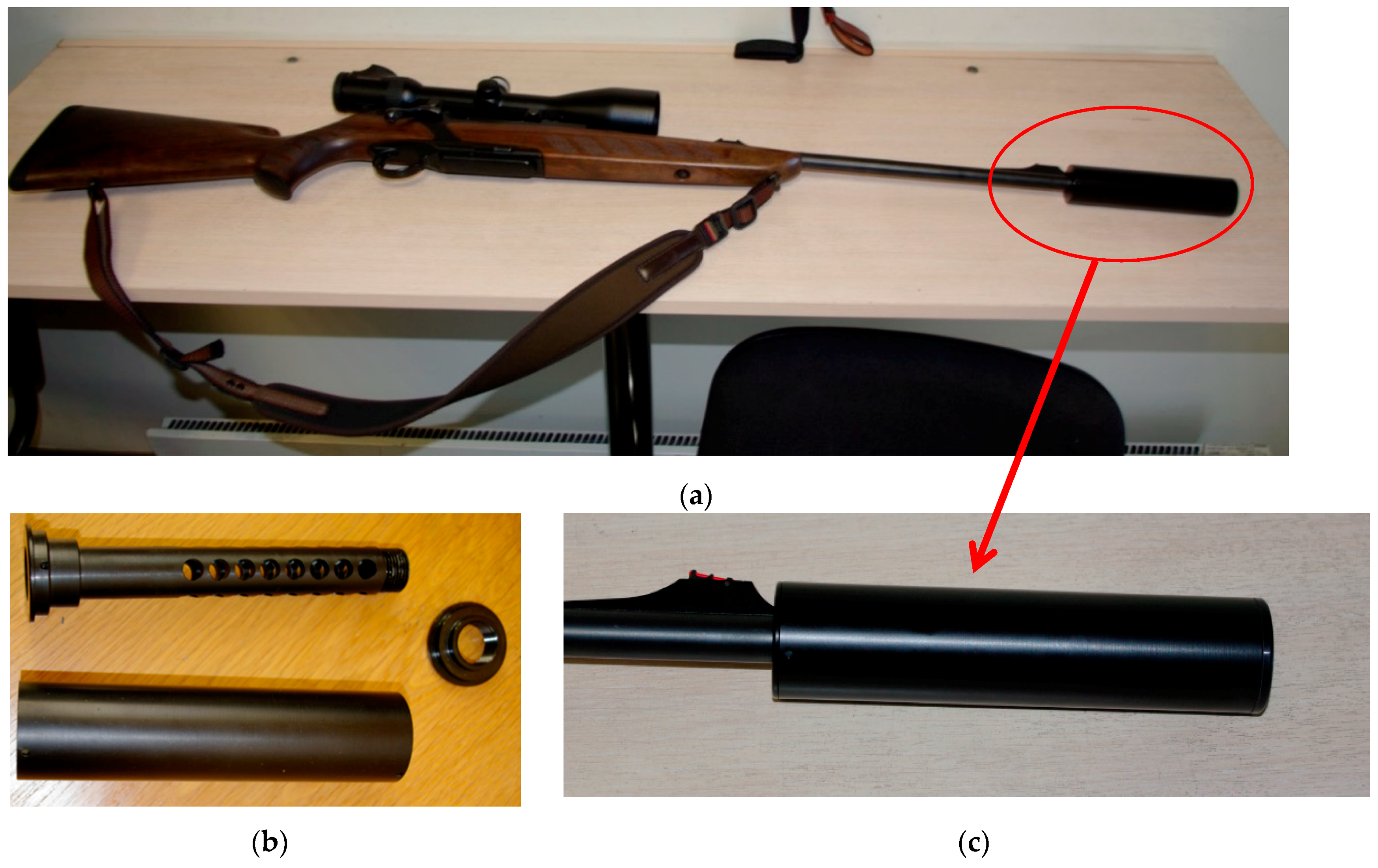
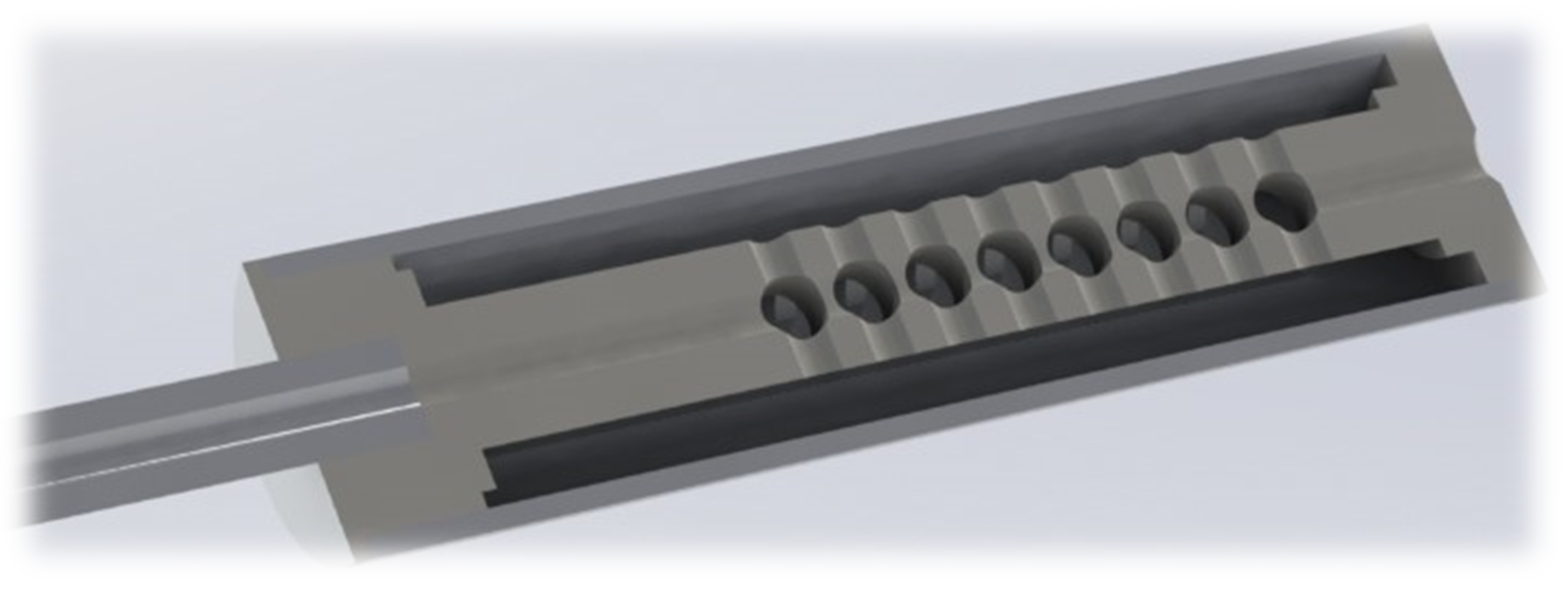


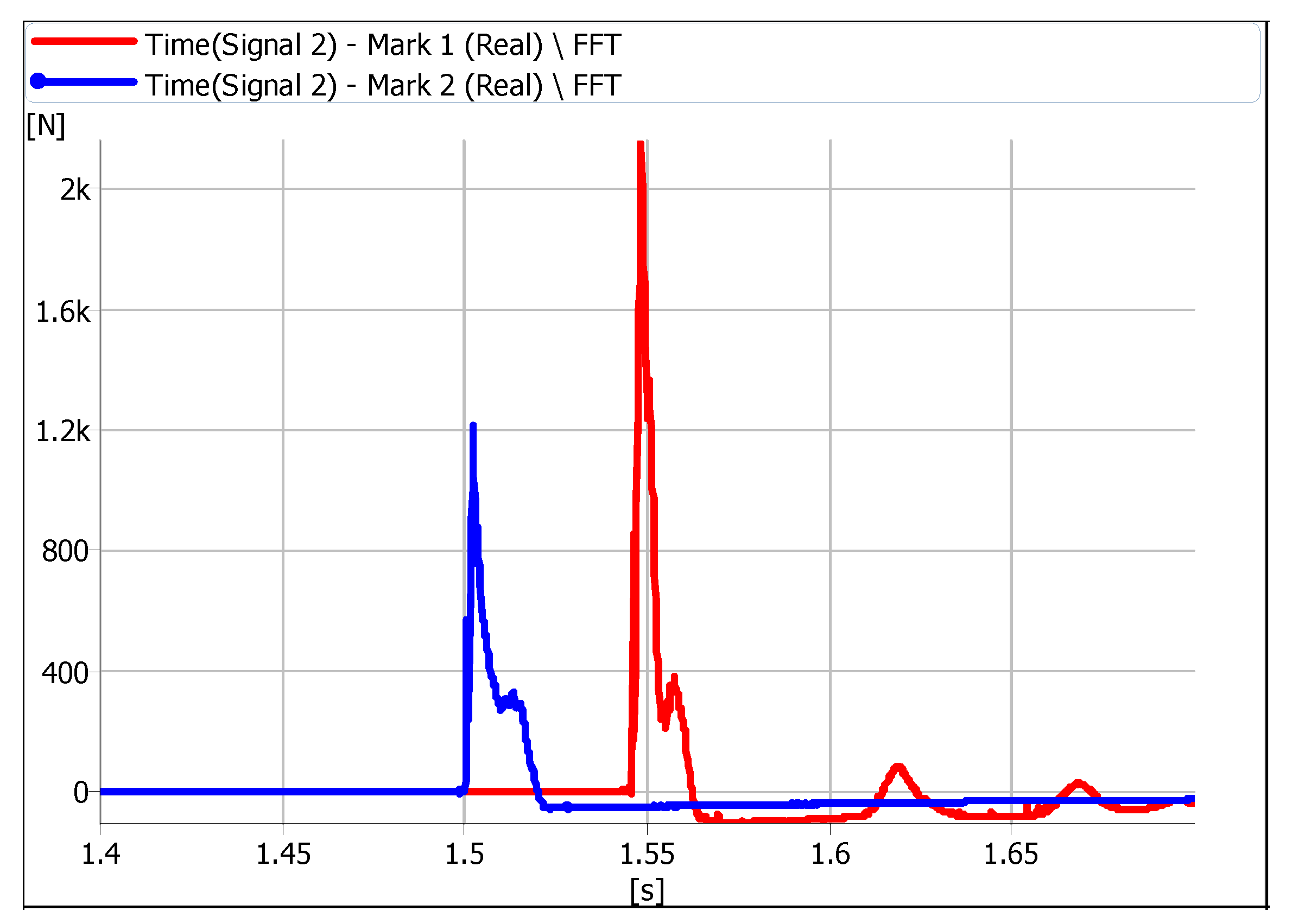
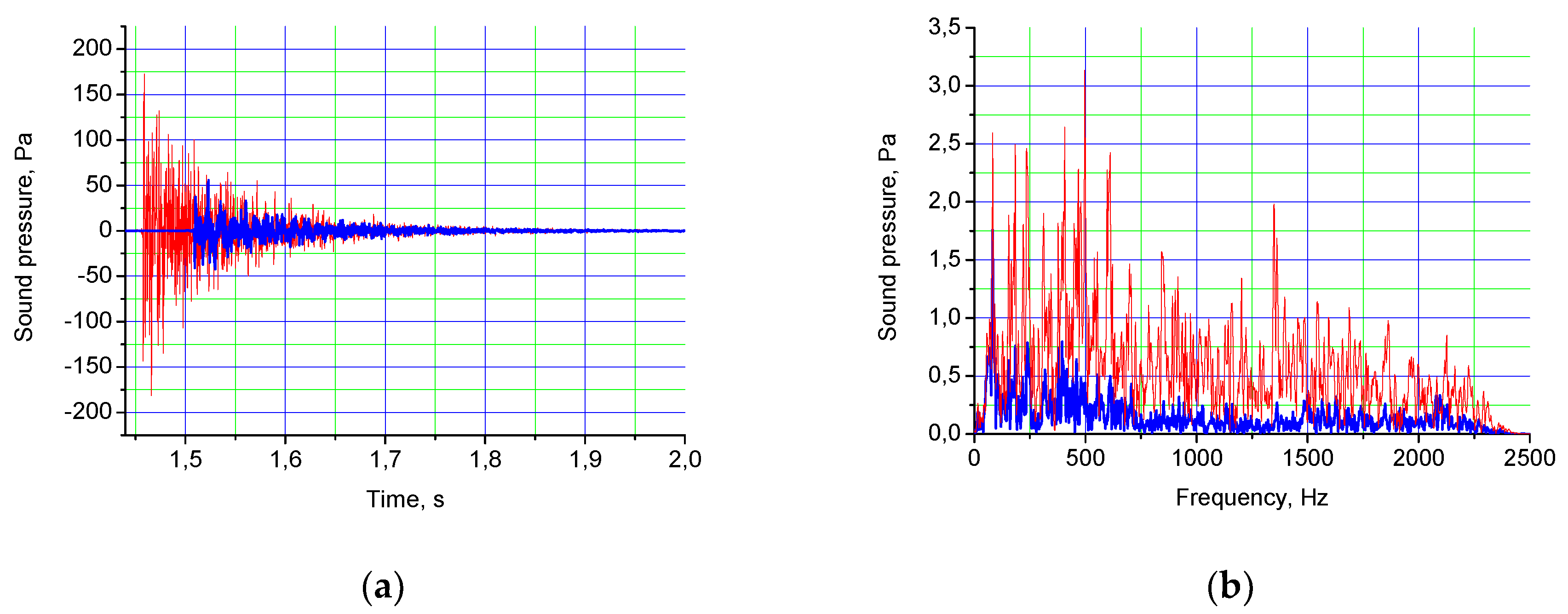

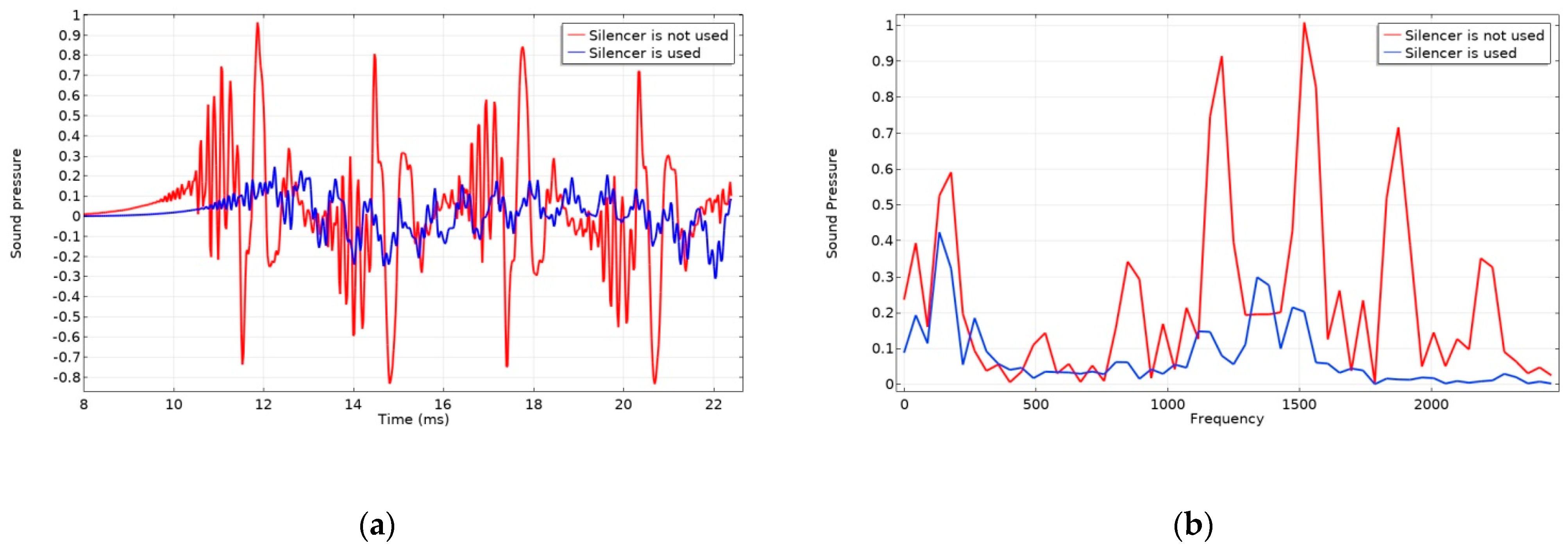
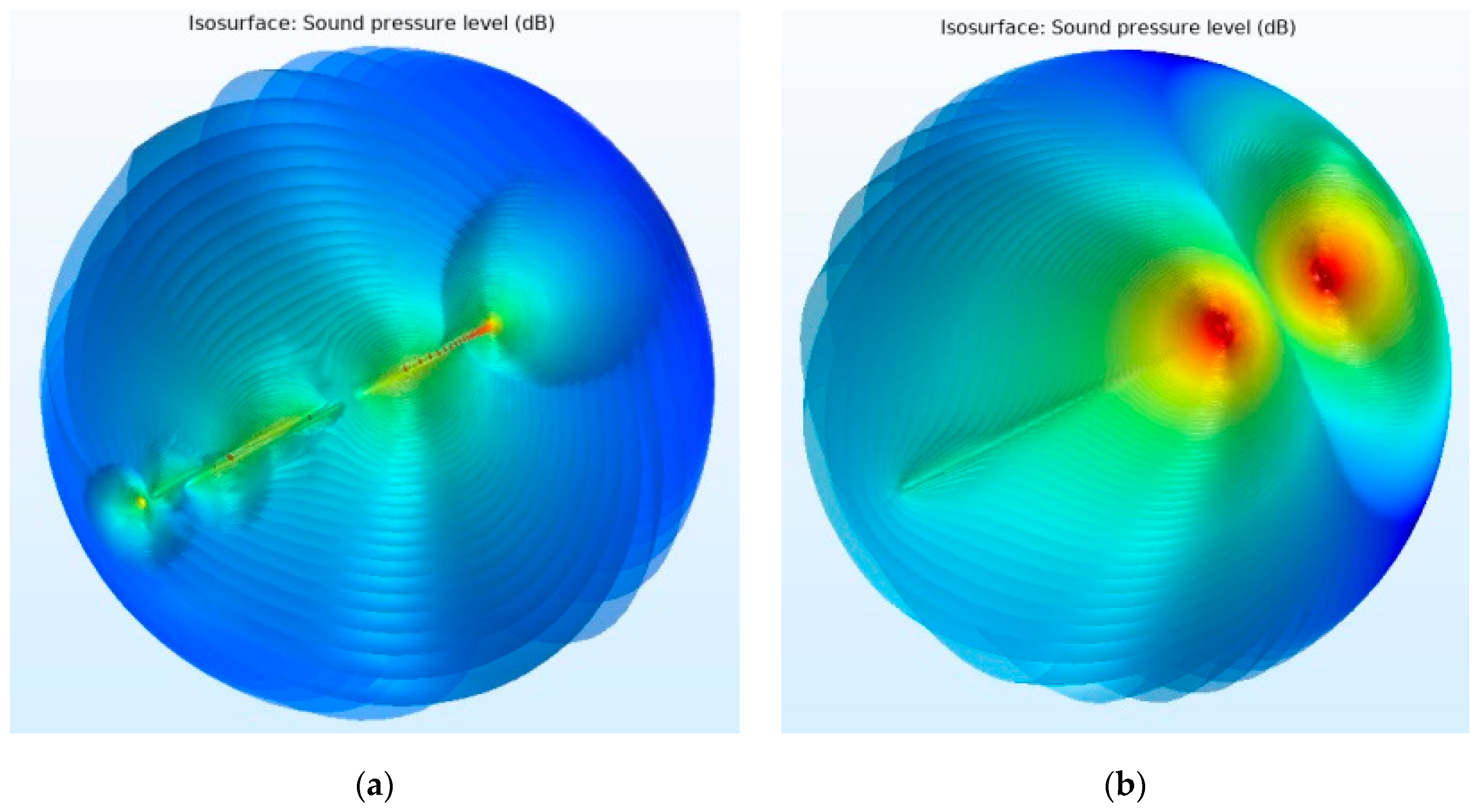
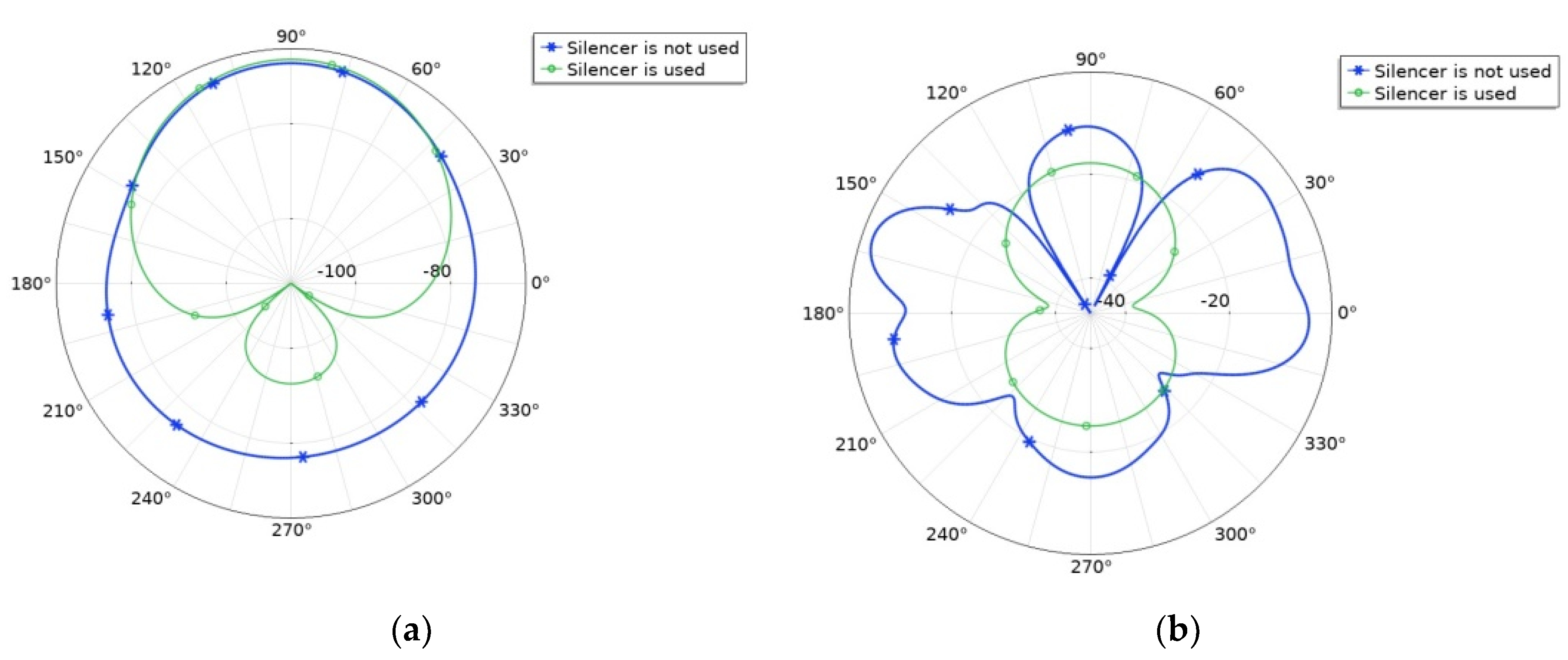
| Setup * | Force, N | |||
|---|---|---|---|---|
| Mean | Standard Deviation | Minimum | Maximum | |
| A | 1195.667 | 10.841 | 1173 | 1214 |
| B | 2192.333 | 4.5056 | 2185 | 2200 |
| Setup * | Sound Pressure, Pa | |||
|---|---|---|---|---|
| Mean | Standard Deviation | Minimum | Maximum | |
| A | 92.517 | 1.505 | 91.3 | 94.2 |
| B | 350.767 | 3.287 | 347.8 | 354.3 |
© 2020 by the authors. Licensee MDPI, Basel, Switzerland. This article is an open access article distributed under the terms and conditions of the Creative Commons Attribution (CC BY) license (http://creativecommons.org/licenses/by/4.0/).
Share and Cite
Selech, J.; Kilikevičius, A.; Kilikevičienė, K.; Borodinas, S.; Matijošius, J.; Vainorius, D.; Marcinkiewicz, J.; Staszak, Z. Force and Sound Pressure Sensors Used for Modeling the Impact of the Firearm with a Suppressor. Appl. Sci. 2020, 10, 961. https://doi.org/10.3390/app10030961
Selech J, Kilikevičius A, Kilikevičienė K, Borodinas S, Matijošius J, Vainorius D, Marcinkiewicz J, Staszak Z. Force and Sound Pressure Sensors Used for Modeling the Impact of the Firearm with a Suppressor. Applied Sciences. 2020; 10(3):961. https://doi.org/10.3390/app10030961
Chicago/Turabian StyleSelech, Jaroslaw, Artūras Kilikevičius, Kristina Kilikevičienė, Sergejus Borodinas, Jonas Matijošius, Darius Vainorius, Jacek Marcinkiewicz, and Zaneta Staszak. 2020. "Force and Sound Pressure Sensors Used for Modeling the Impact of the Firearm with a Suppressor" Applied Sciences 10, no. 3: 961. https://doi.org/10.3390/app10030961
APA StyleSelech, J., Kilikevičius, A., Kilikevičienė, K., Borodinas, S., Matijošius, J., Vainorius, D., Marcinkiewicz, J., & Staszak, Z. (2020). Force and Sound Pressure Sensors Used for Modeling the Impact of the Firearm with a Suppressor. Applied Sciences, 10(3), 961. https://doi.org/10.3390/app10030961






